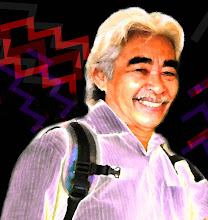Today I went shopping for timber to be used for renovation of my farm's office. I was looking for both hardwood and medium strength wood species. In particular I was looking for hardwood species for posts and medium hardwood for trusses.
Our pick up loaded, Ati fastened the sawn timber for security and stability. The distance from this sawmill to our farm is about 25 km.
Sawn planks of belian timber. This sawmill can custom cut belian from as thick as 30 cm to 4 mm, the later being typical sizes for roofing shingles.
At the sawmill I noticed a good stock of 'belian' timber. 'Belian'( Eusideroxylon zwageri) is the hardest of all hardwoods on Borneo Island. It is not subjected to rot or insects attack. It is so valuable that it is prohibitted to be exported. Locally it is used for numerous purposes especially in view of its superior strength and longevity. I have seen solid round belian timbers used by the locals here especially the Kelabits and Kayans for their longhouses posts. Among the Melanaus who live closer to the coasts and literally build their houses on rivers, belian is the chief timber for house stilts, floors, roofing shingles, jetties, walkways, steps and stairs, bridges and even canoe hulls. Among the Ibans, they use belian posts for pepper vines. In towns, belian timbers are used for wharves and even piles for civil construction purposes. Among the women folks of all the various races here, belian made instruments are like pestles, mortars, pounders for paddy and some children play or games instruments.A Penan burial totem
However of all the uses of belian timber, I find the above to be very unique. It is a burial totem pole called the 'Kelirieng' amongst the Penans and this type of craftwork is also prevalent among other tribes in Bintulu like the Kayans and Kelabit, though I must add that craftwork is seldom carried out these days and the culture related to the burial has been totally prohibited for more than 100 years.
The burial totem is totally made of a solid belian tree and the above size is equivalent to the size of an oil drum. Note the intricate designs that are carved out of the hard belian tree.
The above is a slightly older picture of the same burial totem pole that I managed to pull out from my old photo album. The above 'kelirieng' is still standing in front of the wooden shophouses in Pandan, a rural town about an hour drive from Bintulu. Burial totems are a sign that the bodies of dead chiefs are put to rest there. The chief's remains are placed inside the totem pole . Notice the jar on top of the totem pole. The jar contains the remains of a young girl who unfortunately was sacrified to accompany the dead chief in his after- life journey. This practice has been disallowed since the coming of modern law in Sarawak with the coming of the British rulers. Therefore the 'kelirieng' is more than 100 years old, and so does the belian timber.





















2 comments:
What a beautiful artwork. Is the wood originally white, or is it painted?
I really enjoy visiting your exotic blog.;)
This is not Penan, but PUNAN - of Pandan (today Rh. Nyipa Tingang). Punan and Penan Two different ethnics. This klirieng is belong to Sagieng Selawik, the first Punan moving into Kemena in early 19th century. This klirieng was erected before the "Kayan Expedition". There is another burial pole own by Punan at Labang - relative of Sagieng.
Post a Comment